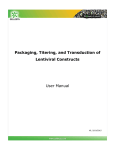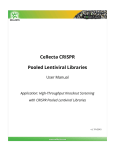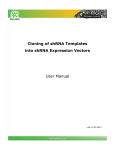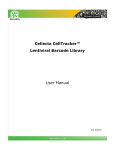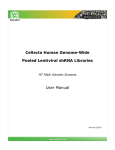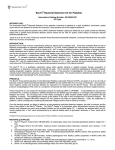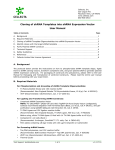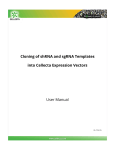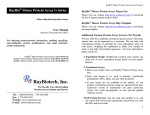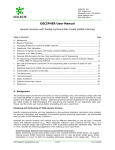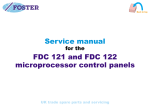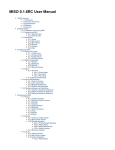Download Pooled Lentiviral shRNA Library Screening Reference
Transcript
Pooled Lentiviral shRNA Library Screening Reference Manual V1, 10/22/2014 ©Cellecta 2014, All Rights Reserved Cellecta Pooled Library Screening www.cellecta.com Reference Manual Contents A. Introduction to Pooled shRNA Libraries ................................................................ 4 B. Design and Quality Control of Cellecta’s shRNA Libraries ............................................. 5 B.1. Synthesis of the Oligos ...................................................................................... 5 B.2. Cloning of the Oligos into Lentiviral Vectors ......................................................... 5 B.3. Unambiguous Sequenceable Barcodes ................................................................. 6 B.4. Effective shRNA Sequences ................................................................................ 6 B.5. Representation Levels of Individual shRNA Sequences ........................................... 6 B.6. Quantifiable HT Sequencing ............................................................................... 7 C. Library Complexity, Maintaining Representation, and Types of Screens ......................... 8 C.1. Library Complexity and Number of Cells .............................................................. 8 C.1.1. Number of Starting Cells and Representation ................................................. 8 C.1.2. Multiplicity of Infection ................................................................................ 9 C.1.3. Representation and Cell Propagation Techniques ............................................ 9 C.1.4. Modular Approach to Genome-Wide Screening ............................................. 10 C.2. Positive Selection Screens (aka. Rescue Screens) ............................................... 10 C.2.1. Length of the Screen ................................................................................. 11 C.2.2. MOI of Transduction .................................................................................. 11 C.2.4. Baseline Controls for Positive Selection Screens ............................................ 11 C.3. Negative Selection Screens (aka. Viability Screens) ............................................ 13 C.3.1. Length of the Screen ................................................................................. 13 C.3.2. MOI of Transduction, Number of Cells to Transduce, Culture and Collect, Amount of DNA to Use for Barcode Amplification .................................................................. 13 C.3.3. Baseline Controls for Negative Screens ........................................................ 14 D. Recommended Pre-Screen Experiments .................................................................. 15 D.1. Doubling Time ............................................................................................... 15 D.2. Calculating a Kill Curve ................................................................................... 16 D.3. Check Toxicity of Polybrene ............................................................................. 16 D.4. Promoter Validation ........................................................................................ 17 E. Packaging Protocol for Pooled Lentiviral shRNA Libraries ...................................... 17 F. Transduction Protocols and Lentiviral Titer Estimation .......................................... 18 F.1. Transduction .................................................................................................. 18 F.1.1. Transduction of Adherent Cells (HEK293 cells) .............................................. 18 [email protected] 2 of 28 v1, 10/22/14 Cellecta Pooled Library Screening www.cellecta.com Reference Manual F.1.2. Alternative Transduction Protocol (Spinoculation) for Suspension Cells ............ 19 F.2. Lentiviral Titer Estimation (RFP assay) ............................................................... 20 G. Calculating the PuromycinR-Titer ............................................................................ 21 H. Troubleshooting .............................................................................................. 23 H.1. Poor Transduction Efficiency ........................................................................ 23 H.2. Transduction Affects Target Cell Viability ....................................................... 24 H.3. No Expression of RFP or PuroR (or shRNAs) in Target Cells ............................... 24 I. Technical Support ........................................................................................... 24 J. Safety Guidelines ............................................................................................ 26 K. References ..................................................................................................... 26 [email protected] 3 of 28 v1, 10/22/14 Cellecta Pooled Library Screening www.cellecta.com Reference Manual A. Introduction to Pooled shRNA Libraries The basis of Cellecta's RNAi genetic screening technology is the stable suppression of specific genes on a large-scale using pooled shRNA libraries, allowing for loss-of-function screens in mammalian cell systems. Genetic screens with shRNA libraries can be utilized to investigate most aspects of biology that can be recapitulated in a cell culture model. As opposed to expressing and assaying the functional effects of an individual shRNA molecule, the development of complex shRNA libraries allows for simultaneous screening of thousands of different shRNA molecules on a target population. In general, genetic screens represent an unbiased approach to identify genes that act in specific cellular pathways. HT RNAi genetic screens have been proven to be an extremely potent and versatile tool to explore the molecular basis of cancer development and progression, and to discover genes essential for viability in cancer cells that can be used as targets for anticancer drug development. The screening process introduces a lentiviral library encoding a highly heterogeneous population of barcoded shRNA constructs that are packaged in viral particles pseudotyped with the vesicular stomatitis virus glycoprotein G (VSV-g) into a population of cells under conditions where most of the cells only take up and express a single gene-specific shRNA. On completion of the screen, cells exhibiting the desired phenotypic changes are isolated, and the shRNA constructs, presumably inducing the phenotypes, are recovered by PCR and identified by HT sequencing of shRNA-specific barcodes. Major advantages of VSV-g pseudotyped lentivectors for shRNA library delivery are: Broad spectrum transduction tropism, allowing efficient transduction of nontransfectable cell types and tissues Long-term silencing of target genes, presenting the possibility of screening functions (senescence, differentiation, growth in soft agar, etc.) that require weeks rather than days in vitro or ex vivo. Genetic screens using pooled shRNA libraries have the requirement for recipient cells with desired phenotypic changes to be selected from a pool of unaffected cells. Selection may be based on cell survival, appearance of specific markers, induction of reporter constructs, changes in cell morphology or behavior, etc. The design of a selection strategy is the most critical arm of any genetic screen project. Repeated rounds of selection may be necessary for either secondary validation or to reduce the number of false positives thereby increasing the percentage of positive hits. [email protected] 4 of 28 v1, 10/22/14 Cellecta Pooled Library Screening www.cellecta.com Reference Manual B. Design and Quality Control of Cellecta’s shRNA Libraries Pooled lentiviral-based libraries containing heterogeneous mixtures of shRNA constructs allow you to assay the effects of many thousands of pooled shRNA-expressing constructs in one experiment. Although Cellecta’s shRNA screening libraries are generated using standard, proven genetic library construction techniques, there are a number of technical challenges to produce quality shRNA expression libraries. B.1. Synthesis of the Oligos For large-scale production of heterogeneous populations of designed oligonucleotides for complex libraries, Cellecta has partnered with Agilent Technologies. Agilent’s microarraybased oligonucleotide synthesis platform provides full-length oligonucleotides over 100 bases in length with minimal mutations. Additionally, the solid support synthesis minimizes bias by providing similar levels of each individual species. B.2. Cloning of the Oligos into Lentiviral Vectors To provide efficient delivery of complex shRNA libraries into different cell types for a variety of experimental designs, we have developed HIV-based lentiviral shRNA cloning vectors with H1 or U6 tet-regulated or constitutive promoters for expression of shRNA and a choice of a single or dual selection marker (GFP, RFP, PuroR, BleoR, etc.) expressed from a single CMV, EF1, PGK, UbiC, or other promoter. Cellecta's HIV-based lentiviral vectors can be packaged as VSV-g pseudotyped viral particles and have a broad range of tropisms for efficient transduction in a wide variety of cells using either a 2nd or 3rd generation lentiviral packaging systems. [email protected] 5 of 28 v1, 10/22/14 Cellecta Pooled Library Screening www.cellecta.com Reference Manual B.3. Unambiguous Sequenceable Barcodes Quality control of the libraries and the final screening representation analysis is greatly facilitated by the incorporation of easily sequenced barcodes in each shRNA construct. The barcodes enable unambiguous identification of each shRNA species with HT sequencing. Depending on the shRNA library that you have chosen, the barcodes and flanking primers will vary. For example, the barcodes in the DECIPHER shRNA library are 18-nucleotides long, while the barcodes in the Human Genome Wide shRNA library are 22 nucleotides long. Upon lentiviral transduction, barcodes integrate into the genomic DNA along with the shRNA expression cassette, and are permanently present but not expressed in the cell. Lastly, some libraries contain clonal barcodes, which enable tracking of individual cell clones expressing specific shRNA sequences. These allow for a wider variety of screening protocols that involve cell proliferation, differentiation, migration, metastasis, or apoptosis in specific clones. Please refer to the User Manual and product analysis certificate for the specific library you are using for detailed information on the barcodes. An example barcode structure is shown below. B.4. Effective shRNA Sequences Cellecta has developed its own in-house shRNA design algorithm that makes use of internal studies primarily focused on the most functionally effective structural features (e.g. length, loop size, mismatches, etc.), combined with published information regarding sequence preferences, and known sequences that have been shown effective for a particular target. B.5. Representation Levels of Individual shRNA Sequences Cellecta specifically designs and constructs pooled shRNA libraries using proven library construction procedures, not by re-amplifying and mixing pre-made individual shRNA constructs. As a result, it is possible to obtain a narrow representation of virtually all [email protected] 6 of 28 v1, 10/22/14 Cellecta Pooled Library Screening www.cellecta.com Reference Manual shRNA. The use of our optimized and unambigious barcodes in combination with HT sequencing enables Cellecta to ensure that more than 99% of shRNA encoding inserts are present in every library and that the representation frequencies of 80-90% of them fall within a 10-fold range. In the shRNA Representation Curve figure below, the upper panel shows a pooled library of 27,000 shRNAs with very good representation. Virtually all the shRNAs are seen between between 100 copies and 1,000 copies in 20 million reads. Thus, there is just a 10-fold difference between the most represented and least for about 90% of the shRNAs. The library has a relatively balanced representation of all shRNAs. On the other hand, the lower panel shows a poor library where almost half of the shRNAs are present at less than 100 copies whereas the others are very highly represented. Overall, the distribution is very broad. It is only possible to get readable signals for about half the shRNAs using the library in the lower panel. This definitive representation data at the start of a screening provides a starting point for the analysis to find shRNAs that significantly increase or decrease during screening, indicating relevant targets. With a poorly defined distribution, it is difficult to differentiate signal vs. noise in any screening assays—or even which shRNA is actually missing in the screen. In other words, you need this data to know what is truly being screened. B.6. Quantifiable HT Sequencing HT sequencing significantly outperforms the hybridization-based approach for identification of individual shRNA species based on the highquality “digital expression data” generated by using barcodes. Even using optimized barcode sequences, array hybridization suffers from a limited dynamic range of approximately 2 orders of magnitude which results in a loss of as much as 30% of the signals that fall outside their effective range. Also, spot-to-spot cross hybridization on arrays results in significant noise that does not occur with HT sequencing where virtually every shRNA in the population is detected and counted, from those present in only a few copies to those present in several million. Differences in shRNA species between control and test populations are very easily detected and statistically analyzed, so that hits can be confidently identified. Number of barcodes [email protected] 7 of 28 v1, 10/22/14 Cellecta Pooled Library Screening www.cellecta.com Reference Manual Example Positive Genetic Screen. The percentage of hits corresponding to known apoptotic genes revealed positive in FASinduced apoptosis of HeLa cell model. C. Library Complexity, Maintaining Representation, and Types of Screens Researchers are often interested in using a pooled shRNA library for genome-wide RNAi screening to cast a very “wide and unbiased net to identify any and all genes functionally involved in some pathway”. Although it is not difficult to make an shRNA library targeting all human or mouse genes, it is difficult to comprehensively screen using such a library. Careful consideration of starting cell numbers and handling of cells during propagation is essential to ensure thorough screening of pooled shRNA expression libraries, minimize false negatives, and obtain consistent and reproducible results. C.1. Library Complexity and Number of Cells First, there is an issue of library complexity since it is necessary to have several shRNAs designed to target each gene. The effectiveness of validated shRNA varies from cell-to-cell. For these reasons, it is necessary to incorporate several shRNAs for each gene to ensure reasonable knockdown of a high percentage of targets. Cellecta typically designs 5-10 shRNAs against each target gene depending on the design of the library, so at least 25,000 shRNAs are required to target 2,500-5,000 genes. A library targeting the entire human genome of approximately 20,000 genes requires approximately 115,000 individual shRNA constructs. While it is not particularly difficult to construct libraries of this complexity, this number of unique shRNA sequences can produce technical challenges with some types of screens. C.1.1. Number of Starting Cells and Representation Pooled shRNA library screens require quantification of changes in the fraction of cells bearing each shRNA sequence in selected vs. control cells (or starting library). A “hit” occurs when selected cells have significantly more or fewer cells bearing a particular shRNA sequence. Whether one is looking at enrichment of shRNA sequences in the selected cell population vs. control (positive selection) or depletion of shRNA sequenced in selected cell population vs. control (negative selection), it is critical that the screens begin with sufficient numbers of cells [email protected] 8 of 28 v1, 10/22/14 Cellecta Pooled Library Screening www.cellecta.com Reference Manual expressing each shRNA to ensure measured changes in the fraction of cells bearing any given shRNA sequence are statistically significant. This means that, if there are very low numbers of cells bearing specific shRNA sequences at the start of the screen, small random changes in a drifting population may be difficult to differentiate from significant trends. Simply put, a loss of 2 cells is a 20% change if there are only 10 initially vs. 2% if there are 100. For this reason, a least a few hundred cells need to be infected with each shRNA to initiate a good screening. This is demonstrated in the Reproducibility of Triplicate figure below where starting with a smaller population of just 50 cells per shRNA (third bar) leads to significantly more variation than starting with a population of 200 cells per shRNA (first bar). To ensure adequate representation of the whole library in the initial population, start a screen by infecting at least 200 times more cells than the complexity of the library. For a library with 25,000 shRNAs, the starting population should be at least 5 million infected cells, and for a library with 55,000 shRNAs, the starting population should be at least 11 million infected cells. C.1.2. Multiplicity of Infection For pooled shRNA screens, it is important to have 2-3 times more cells than infecting viral particles (i.e., a multiplicity of infection [MOI] of 0.3-0.5) to ensure that the majority of cells are only infected with one shRNA-carrying virus, so you need to have 2-3 times more cells than the number targeted for infection. Thus, 6-8 million cells are needed to start a screen with libraries of 25,000 shRNAs, and a whole genome library of 150,000 shRNAs would require 60-90 million cells. Since each screen should be done in duplicate, or better, triplicate, the number of cells needed makes a full genome screen with a redundant shRNA library challenging. The lower the MOI, the more cells you need to start the screen so it is tempting to use a high MOI. However, you should consider that a higher MOI produces a higher percentage of infected cells bearing two or more different shRNA constructs. For most RNAi screens, we [email protected] 9 of 28 v1, 10/22/14 Cellecta Pooled Library Screening www.cellecta.com Reference Manual recommend optimizing conditions and performing genetic screen transductions at no more than 0.5 MOI (ca. 40% transduction efficiency) which balances these two considerations. Please note that to accurately calculate the MOI, it is critical to determine the library titer directly in your target cells prior to beginning your experiment. Once conditions are established to achieve ~40% transduction efficiency in the titering assay, scale up all conditions proportionately to accommodate the larger amount of transduced cells needed for the genetic screen. C.1.3. Representation and Cell Propagation Techniques Finally, to ensure a comprehensive screen, it is not simply sufficient to start with the right amount of cells. During the screening process, incorrect propagation of the cells can completely undercut the representation set up at the initiation of the screen. This is especially true for a negative selection screen, such as a viability screen where one is interested in identifying shRNA that kill or inhibit proliferation of cells, and, therefore, drop out of the population. It is critical to maintain the full library representation that was initially used at the start of the screen. If a portion of propagating cells are removed during propagation (e.g. cells are split), the representation of the library can be skewed in the sample which introduces significant random noise. This effect is readily seen in the second bar in the Reproducibility of Triplicates figure where the effect of starting with sufficient cells (i.e. 200-fold library complexity) is completely undercut by splitting cells during propagation so that that the final count of cells after 10 days is the same as the initial number of transduced cells (i.e. 200-fold library complexity). The correlation between triplicates falls dramatically when the cells are split to this degree. For this reason if cells are ever to be discarded or samples split at any time during the screen, the number of remaining cells in each sample should always exceed the complexity of the library by at least 1,000-fold, as shown in the first bar of the figure. For example, keep at least 27 million cells after every splitting step, for a 27K library. Also, before splitting or discarding, make sure you first pool all cells from the same replicate together. C.1.4. Modular Approach to Genome-Wide Screening Library representation is often overlooked, especially when the desire is for large-scale unbiased screens. However, without careful consideration in designing screening procedures that reflect the complexity of the library, results of these large-scale screens can produce relatively meaningless data with anecdotal results at best. So, what about genome-wide screening? Our approach is to provide modules, each targeting approximately 5,000 genes with 27,500 shRNA in our DECIPHER library, or targeting 6,500 with 55,000 shRNA in our Human Genomewide (hGW) library. These modules enable comprehensive genome-wide screens with manageable numbers of cells for negative selection screens. For cases where it is practical to work with larger numbers of cells, for example some positive screens, the modules of the hGW library can be combined to make a larger library since they contain nonoverlapping barcodes. C.2. Positive Selection Screens (aka. Rescue Screens) Find genes required to produce a response to added factors or compounds, for example, genes necessary for trigging apoptosis or cell death in response to FAS, PUMA or other effectors. Positive screens are also known as enrichment screens. Many positive screens use FACS to look for modulators of signaling molecules like NF-κB, p53, c-myc, HSF-1, HIF-1α using [email protected] 10 of 28 v1, 10/22/14 Cellecta Pooled Library Screening www.cellecta.com Reference Manual fluorescent reporter cell lines, or cells expressing specific antibody-detectable markers, such as specific receptors. C.2.1. Length of the Screen A positive screen involves a selection that eliminates most of the cells. With this sort of screen, the goal is to isolate a small population of cells with shRNAs that enable the cells to pass through the selection step. The critical factor here then is the nature of the selection, which ultimately determines the screen procedure. In most cases, it is advisable to wait about 1 week after library transduction before carrying out the selection step. The 1 week wait period is needed to allow for knockdown of genes encoding for long half-life mRNAs and proteins, and the development of the resistant phenotype before applying selection. Cells should then be harvested as soon as positive selection is completed. Growing and expanding clones after positive selection is not advised. For a positive selection screen, the puromycin or other antibiotic selection of transduced cells it is not essential, but provides a way to reduce the total number of cells before positive selection and makes cell culture handling more manageable. C.2.2. MOI of Transduction A positive screen involves isolation of a small population of cells with shRNA sequences that will be over-represented or enriched when compared to the starting library shRNA counts. As with any screen, to ensure reproducible and reliable results, it is critical that you transduce enough cells to maintain sufficient representation of each shRNA construct present in the library. The number of cells stably transduced with the shRNA library at the time of transduction should exceed the complexity of the shRNA library by at least 200-fold. For a library with 27,500 shRNAs, the starting population should be at least 5.5 million infected cells, and for a library with 55,000 shRNAs, the starting population should be at least 11 million infected cells. C.2.3. Maintenance of the Cells A positive selection screen often involves the comparison of two types of samples: selected and unselected (control) samples. After transduction and before selection, it is best practice not to discard any cells. However, this is often not practical. If cells have to be discarded or split before selection, the number of remaining cells in each sample should always exceed the complexity of the library by at least 1,000-fold (e.g. keep at least 2.7 × 107 cells after every splitting step, for a 27K library). After the selection step, all the cells in the selected samples should be collected for genomic DNA purification and barcode PCR amplification. For the control samples, follow the abovementioned 1,000-fold rule in the sense that you should collect enough cells to equal 1,000fold the complexity of the library. Similarly, when amplifying barcodes from isolated DNA, you should always use all the genomic DNA recovered from cell samples, up to the amount corresponding to 1000X cells the library size. For diploid cells, 25-30 million cells ~150-180 µg of genomic DNA. C.2.4. Baseline Controls for Positive Selection Screens In order to calculate the enrichment-fold of the shRNA sequences present in the selected population, a baseline control is needed. Depending on the screen, the plasmid library itself can be used as baseline, or pre-selection cells, or mock-selected cells. [email protected] 11 of 28 v1, 10/22/14 Cellecta Pooled Library Screening www.cellecta.com Reference Manual C.2.5. Examples of Positive Selection Screens Positive Selection Screen 1 Aim: Identifying genes whose knockdown confers resistance to cytotoxic compound X. Cytotoxic compound X kills 95%-99% cells within 48h when administered at 1nM concentration. shRNA library used: 55K HGW1 Procedure: Day 1: 5x107 cells transduced at MOI 0.5 (40% transduction efficiency expected) Day 2: Media change Day 4: Actual transduction efficiency checked by flow cytometry. Start of puromycin selection (1ug/ml) Day 7: End of puromycin selection Day 8: Culture split 50:50 into 2 samples (>1x108 cells/sample) Sample A: cytotoxic compound X added at 1nM concentration Sample B: untreated Day 10: Both samples harvested for genomic DNA isolation and HTseq sequencing of integrated barcodes. For the untreated sample, 400ug of genomic DNA is used for barcode PCR and HTseq sequencing. For the treated sample, all the recovered genomic DNA is used. shRNAs are evaluated based on barcode enrichment in sample A vs sample B gene hits are identified based on evaluation of targeting shRNAs Positive Selection Screen 2 Aim: Identifying genes required for the transactivation of promoter X by compound Y. GFP is expressed from promoter X, and accumulates in cells within 24h of stimulation by compound Y at 10nM concentration. shRNA library used: 55K HGW1 Procedure: Day 1: 5x107 cells transduced at MOI 0.5 (40% transduction efficiency expected) Day 2: Media change Day 4: Actual transduction efficiency checked by flow cytometry. Start of puromycin selection (1ug/ml) Day 7: End of puromycin selection Day 8: Compound Y added at 10nM concentration. Day 9: 1x108 cells sorted by FACS into two samples: Sample A: bottom 1% dimmest GFP cells Sample B: top 50% brightest GFP cells Both samples are harvested immediately after sorting for genomic DNA isolation and HTseq sequencing of integrated barcodes. For the top 50% population, 400ug of genomic DNA is used for barcode PCR and HTseq sequencing. For the bottom 1% population, all the recovered genomic DNA is used. shRNAs are evaluated based on barcode enrichment in sample A vs sample B gene hits are identified based on evaluation of targeting shRNAs [email protected] 12 of 28 v1, 10/22/14 Cellecta Pooled Library Screening www.cellecta.com Reference Manual C.3. Negative Selection Screens (aka. Viability Screens) A standard dropout viability screen (negative selection screen) relies on the fact that some of the shRNAs in the screen are either cytotoxic or cytostatic (presumably by interfering with an essential target gene). Cells with shRNAs that do not inhibit growth, then, grow normally populating the culture in which the cells with the lethal shRNA do not propagate. The endpoint analysis involves looking for shRNA sequences that are underrepresented or depleted in the sample population relative to the original library. C.3.1. Length of the Screen For a dropout viability screen to work, the cells need to be cultured long enough for the cells with unaffected growth to significantly increase their proportion relative to the affected cells. For this to occur, the cells need enough time in culture for multiple doublings. The length of any particular screen may need to be altered depending on the specifics (e.g. cell growth rates, types of targets of interest, if additional compounds are used). However, typically, we find allowing for ~10 population doublings after transduction to be optimal. If the screen is not run long enough, all the shRNA counts will be in a narrow range and it will be difficult to identify significantly depleted shRNA sequences from background variability. If the screen is run too long, the range of representation of shRNA sequences will become broader due to the natural growth variance in different cells in the population. This phenomena, often referred to as genetic drift, will increase the background variance of the screen and, if the spread becomes too broad, can also make it difficult to identify significantly depleted shRNAs from background variability. For optimal results, it is important to run the screen long enough that shRNAs that have an effect on cell growth/viability will be distinct from background variance but not to the point where background variance becomes large enough to confound the ability to call hits. For a negative selection screen, the puromycin or other antibiotic selection it is not essential, but provides a way to reduce the total number of cells and makes cell culture handling more manageable. In a typical screen about 30%-40% cells are transduced, the remaining 60%70% of cells without virus are not needed. Unless you want to maintain a larger than needed cell population throughout the screen, it makes sense to perform antibiotic selection to get rid of unwanted cells. C.3.2. MOI of Transduction, Number of Cells to Transduce, Culture and Collect, Amount of DNA to Use for Barcode Amplification As mentioned above, the number of cells stably transduced with the shRNA library at the time of transduction should exceed the complexity of the shRNA library by at least 200-fold. For a library with 27,500 shRNAs, the starting population should be at least 5.5 million infected cells, and for a library with 55,000 shRNAs, the starting population should be at least 11 million infected cells. The MOI of transduction should be kept at or below 0.5, to ensure that the majority of transduced cells carry only one integrated provirus. After transduction, the ideal is to never discard any cells at any time during the experiment (e.g. at treatment, harvesting, DNA purification, etc.). However, this is often not practical— especially for a negative screen where most of the cells propagate normally. If the number of cells becomes too large and you are forced to discard a fraction, the number of remaining [email protected] 13 of 28 v1, 10/22/14 Cellecta Pooled Library Screening www.cellecta.com Reference Manual cells should always exceed the complexity of the library by at least 1,000-fold (e.g. keep at least 27 million cells after every splitting step, for a 27K library). Similarly, when amplifying barcodes from isolated DNA, you should always use all the genomic DNA recovered from cell samples, up to the amount corresponding to 1000X cells the library size. C.3.3. Baseline Controls for Negative Screens In a simple screen aimed at identifying shRNAs which are cytotoxic in a given cell line, we typically use the library itself as the baseline control, since the shRNA frequency distribution in plasmid and packaged lentiviral library is virtually identical. The plasmid library has already been sequenced as part of the QC when we made the library, so it is not necessary to resequence the library at this point. If you would also like to use transduced cells as a baseline control, typically we recommend harvesting and sequencing genomic DNA from them by about 18 hours post-transduction so that the cells have not had too much time to proliferate and express shRNAs to affect the library distribution. In more complex experiments, aiming at identifying differential toxicity between isogenic cell lines, or between compound-treated and non-treated cells, other baselines will be needed. C.3.4. Examples of Negative Selection Screens Negative Selection Screen 1 Aim: Identifying shRNAs that are differentially cytotoxic in cell line A vs cell line B. shRNA library used: 55K HGW1 Cell lines A and B have a doubling time of ~36h Procedure: Day 1: 5x107 cells/cell line transduced at MOI 0.5 (40% transduction efficiency expected) Day 2: Media change Day 4: Actual transduction efficiency checked by flow cytometry. Start of puromycin selection (1ug/ml) Day 7: End of puromycin selection, ~3x108 cells/sample. In some cases, it can be appropriate to keep puromycin throughout the experiment. All cells from each sample are pooled together and re-plated at 6x107 cells/sample Day 10: All cells from each sample are pooled together and re-plated at 6x107 cells/sample Day 13: All cells from each sample are harvested for genomic DNA isolation and HTseq sequencing of integrated barcodes. 400ug genomic DNA/sample is used for barcode amplification and HTseq. shRNAs are evaluated based on barcode depletion in sample A vs sample B gene hits are identified based on evaluation of targeting shRNAs [email protected] 14 of 28 v1, 10/22/14 Cellecta Pooled Library Screening www.cellecta.com Reference Manual Negative Selection Screen 2 Aim: Identifying shRNAs that synergize with cytotoxic effect of compound X in cell line A. Compound X has IC50= 1nM when administered continuously for 7 days. shRNA library used: 55K HGW1 Procedure: Day 1: 5x107 cells transduced at MOI 0.5 (40% transduction efficiency expected) Day 2: Media change Day 4: Actual transduction efficiency checked by flow cytometry. Start of puromycin selection (1ug/ml) Day 7: End of puromycin selection, ~3x108 cells. In some cases, it can be appropriate to keep puromycin throughout the experiment. Cells are pooled and re-plated into 2 separate samples, 6x107 cells/sample. Sample A is treated with 1nM compound X, sample B is mock-treated Day 10: All cells from each sample are pooled and re-plated at 6x10^7 cells/sample. Sample A is still treated with 1nM compound X, sample B is still mock-treated. Day 13: All cells from each sample are harvested for genomic DNA isolation and HTseq sequencing of integrated barcodes. 400ug genomic DNA/sample is used for barcode amplification and HTseq. shRNAs are evaluated based on barcode depletion in sample A vs sample B gene hits are identified based on evaluation of targeting shRNAs D. Recommended Pre-Screen Experiments As with all lengthy experiments, it is important to work out some of the details of your system before performing the key protocols. These suggestions will help you to get the most reliable data from your screen, in the shortest amount of time. It is important to do the following pilot studies in the model cell system that you will use for the pooled library screen, as the results may be cell-type specific. D.1. Doubling Time The doubling time is the time it takes your cells to double in number. It is useful to know the doubling time of your cells so that you can plate the appropriate number for transduction with the lentiviral library. Start with cells that have already been growing for a few weeks, rather than using cells that have just been thawed from a frozen state. To calculate the doubling time, trypsinize your cells as if you were going to split them. Count them using a hemacytometer or cell counter and keep track of the number that you replate onto the cell culture plates. The starting number of cells is Xb. Propagate the cells as you normally do, replacing media as necessary. The next time they are ready to be split, trypsinize them as usual, and count them again using a hemacytometer or cell counter. The number of cells at the end is referred to as Xe. The cells should be in the log phase of growth to calculate doubling time properly, so it is important to not let the cells become confluent. To calculate the doubling time, use the following formula: [email protected] 15 of 28 v1, 10/22/14 Cellecta Pooled Library Screening www.cellecta.com Reference Manual 𝐷𝑜𝑢𝑏𝑙𝑖𝑛𝑔 𝑇𝑖𝑚𝑒 = 𝑇(𝑙𝑛2) 𝑋𝑒 ln( ) 𝑋𝑏 where T= Time in any units (in this case days) For Example, let’s say that on Day 0, you count 2x106 cells. Three (3) days later, you count the cells at 16x106 cells. Xb= 2x106 T= 3 days Xe= 16x106 𝐷𝑜𝑢𝑏𝑙𝑖𝑛𝑔 𝑇𝑖𝑚𝑒 = 3(𝑙𝑛2) 3(0.69) 2.08 = = = 1 𝑑𝑎𝑦 16,000,000 ln(8) 2.08 ln( ) 2,000,000 D.2. Calculating a Kill Curve Most vectors from Cellecta that are used to make pooled shRNA libraries have an antibiotic resistance gene, which allows you to select the cells that have received a copy of the shRNA. In order to successfully select your cells, you need to know the concentration of antibiotic that kills your untransduced cells within a given amount of time. Antibiotic selection is not necessary for most screens, but it is a convenient way of removing excess cells that have not received the lentiviral vector. It is helpful to use minimal levels of antibiotic so as not to kill cells that just have a weaker expression of the antibiotic resistance gene. Many vectors contain a puromycin resistance gene, therefore we will use this example as to the method of calculating a puromycin kill curve. Aliquot cells in a 12-well plate at such a density so they are at 72 hours from confluence. Add puromycin at 0 μg/ml, 0.5 μg/ml, 1 μg/ml, 2 μg/ml, 5 μg/ml, and 10 μg/ml in six different wells. Mix and return cells to incubator. Grow cells under standard conditions for 72 hours, then count viable cells and determine the lowest concentration of puromycin that kills >90% of cells in 72 hours. Use this concentration at puromycin selection step during the screen. D.3. Check Toxicity of Polybrene Polybrene is a transduction enhancement reagent used during transduction of the pooled shRNA lentiviral library into the target cells. Polybrene is a polycation that neutralizes charge interactions to increase binding between the lentiviral envelope and the plasma membrane. The optimal concentration of Polybrene depends on cell type and may need to be empirically determined. Excessive exposure to Polybrene can be toxic to some cells. Before transducing your target cells we recommended performing a Polybrene toxicity titration. In a 12-well plate, grow cells in complete culture medium with a range of Polybrene concentrations (0 μg/ml, 1 μg/ml, 2 μg/ml, 3 μg/ml, 4 μg/ml, 5 μg/ml) for 24 hours. Then, replace old medium with Polybrene-free complete culture medium and grow cells for an additional 72 hours. Check for toxicity by counting viable cells. For your experiments, use the highest concentration of Polybrene that results in less than 10% cell toxicity compared to no Polybrene (typically, 5 μg/ml is recommended). For some cell types, you cannot use Polybrene. [email protected] 16 of 28 v1, 10/22/14 Cellecta Pooled Library Screening www.cellecta.com Reference Manual D.4. Promoter Validation If you have not used lentiviral vectors in your target cells before, you may wish to do a pilot experiment to determine which promoters will work best. In the pooled shRNA libraries, the vectors have a cDNA promoter for expression of the RFP and Puro resistance, as well as a shRNA promoter for expression of the shRNA. Cellecta sells pre-packaged viruses expressing different marker genes from different promoters. You can use these to determine which promoter combination will work the best for your cells. For more information, please see: http://www.cellecta.com/products-and-services/pooled-lentiviral-libraries/control-shRNAconstructs/. E. Packaging Libraries Protocol for Pooled Lentiviral shRNA If the library you purchased was provided in plasmid form, you will need to package it into lentiviral particles before using it in your target cells. Please refer to the User Manual specific to the library you have purchased for a detailed protocol on lentiviral packaging. The viral packaging protocols used for pooled shRNA libraries differ from those used for regular viral packaging. The main difference is that in order to maintain representation of all of the individual shRNAs for the screen, a large-scale viral packaging protocol is needed. If packaging is done on too small a scale, it can skew the representation of the library. Cellecta offers lentiviral packaging services. Please contact us at [email protected] or visit http://www.cellecta.com/products-and-services/lentiviral-packaging/ for more information. [email protected] 17 of 28 v1, 10/22/14 Cellecta Pooled Library Screening www.cellecta.com Reference Manual F. Transduction Protocols and Lentiviral Titer Estimation The following section uses packaged lentiviral particles for transduction into example target cells (HEK293). Please note that lentiviral particles should only be opened within the laminar flow hood, and should be used under biosafety Level 2 conditions. For more information on the biosafety of lentiviral particles, please refer to [email protected] 18 of 28 v1, 10/22/14 Cellecta Pooled Library Screening www.cellecta.com Reference Manual J. Safety Guidelines, below. F.1. Transduction Lentiviral transductions are performed by mixing cells and virus in culture media supplemented with Polybrene®. For both adherent and suspension cells, transductions are initiated in suspension and carried out overnight. Adherent cells are allowed to adhere to substrate during transduction and are transduced at a cell density that allows for 2-3 population doublings before reaching confluence. Suspension cells are typically transduced at higher density than standard growth density, and then they are diluted to standard growth density 18-24 hours after transduction. F.1.1. Transduction of Adherent Cells (HEK293 cells) The following protocol has been optimized for HEK293 cells. For other adherent cell types, parameters such as media, growth surface, time of detection, etc. will have to be adjusted. Day 1 1. Quickly thaw the lentiviral particles in a water bath at 37°C. Transfer the thawed particles to a laminar flow hood, gently mix by rotation, inversion, or gentle vortexing, and keep on ice. CAUTION: Only open the tube containing the lentiviral particles in the laminar flow hood. NOTE: Unused lentiviral stock may be refrozen at –80°C, but it can result in unpredictable loss of titer. 2. Trypsinize and resuspend HEK293 cells to a density of 1 × 105 cells/ml in D-MEM supplemented with 10% FBS and 5 μg/ml Polybrene. Aliquot 1 ml/well in a 12-well plate and add 0 μl, 3 μl, 10 μl, 33 μl, and 100 μl of lentiviral stock (supernatant filtered to remove cells and cell debris, not concentrated) to six different wells. If concentrated virus is used, scale down virus volumes accordingly. Mix and return cells to CO2 incubator. Grow cells under standard conditions for 24 hours. NOTE: It is important to accurately record the original # of cells at Time of Transduction, as this is critical in titer calculation. For adherent cells other than HEK293, choose a different # of cells at time of transduction, depending on cell size. As a rule of thumb, cells should be transduced at such a density such that they would become confluent in ~48 hours. [email protected] 19 of 28 v1, 10/22/14 Cellecta Pooled Library Screening www.cellecta.com Reference Manual Day 2 3. Between 16h-24 hours post-transduction, replace media with fresh D-MEM supplemented with 10% FBS and without Polybrene. Return cells to CO2 incubator, and grow under standard conditions for additional 48 hours. Avoid confluence: trypsinize and re-plate cells if needed. Day 4 (72 hours after transduction) 4. Detach cells from the plate by trypsin treatment, block trypsin with FBS/media, centrifuge, resuspend in 1X D-PBS, and determine the % of transduced (RFP-positive) cells by flow cytometry. NOTE: Attempting to determine the % of transduced cells by fluorescence microscopy is NOT RECOMMENDED. IMPORTANT: Flow cytometry settings to detect RFP-positive cells are the following: Excitation: 561nm (530nm laser is still acceptable), Emission: 600/20 band-pass filter, or similar (for TagRFP). 5. Proceed to Lentiviral Titer estimation (RFP assay). F.1.2. Alternative Transduction Protocol (Spinoculation) for Suspension Cells The following protocol has been optimized for K-562 cells. For other cell types, parameters such as media, growth surface, time of detection, etc. will have to be adjusted. 1. K-562 cells are transduced (“infected”) using spinoculation. This is performed using multiwell tissue culture plates and a tabletop centrifuge capable of 1,200 × g and centrifugation of multi-well plates. 2. Grow K-562 cells and maintain them between 2 × 105 and 1 × 106 cells/ml. Do not let them become too dense or let the medium become yellow at any point. 3. For lentiviral library titration, K-562 cells are resuspended at 2 × 106 cells per ml in RPMI 10% FBS supplemented with 20mM HEPES pH7.4 and Polybrene 5 μg/ml. 0.5-ml aliquots are placed into each well in a 24-well plate (1 × 106 cells/well total). This cell density has proven effective for many suspension cell lines in-house at Cellecta. To each cellcontaining well, add increasing amounts of lentiviral stock to be titered. For standard 100-fold concentrated lentiviral stock, add 0 μl, 0.3 μl 1 μl, 3 μl, and 10 μl virus. Close the plate, mix by gentle agitation, wrap the perimeter with parafilm, and place the plate into centrifuge with an appropriate balance and centrifuge at 1,200 × g at +25°C for 2 hours. 4. Following centrifugation, remove plate(s) from centrifuge, carefully remove parafilm, and place in incubator. After 3 hours, “feed” cells with 0.5 ml additional complete medium per well (no Polybrene). 5. 24 hours after spinoculation, resuspend cells at 2 × 105 cells/ml in RPMI 10% FBS in the appropriate culture vessel and grow for additional 48 hours. 6. 72 hours after spinoculation, perform titer as previously described. NOTE: Use larger vessels for large-scale genetic screen transductions. Scale up all volumes accordingly. [email protected] 20 of 28 v1, 10/22/14 Cellecta Pooled Library Screening www.cellecta.com Reference Manual F.2. Lentiviral Titer Estimation (RFP assay) Lentiviral shRNA vectors that express the fluorescent protein TagRFP (excitation ~560nm emission ~590nm) allow lentiviral titer estimation by flow cytometry (RFP assay) or by a combined flow cytometry/puromycin resistance assay (RFP/PuroR assay). To check lentiviral titer, we recommend always using the same cells you will use in the screen. Most of the commonly used mammalian cell lines can be effectively transduced by lentiviral constructs. Relative titers can vary up to 50-fold depending on the chosen cell line. Lentiviral titer is measured as Transduction Units/ml (TU/ml). One TU produces one integration event in target cells. Integration events can be calculated from observed % of transduced cells according to the table below. TITER CHART 100 90 80 % infected cells 70 60 50 40 30 20 10 0 0 0.5 1 1.5 2 2.5 MOI (integrations/cell) The % of infected cells is determined by flow cytometry (excitation=561nm, emission=600/20 for TagRFP) by observing the % of RFP+ cells in the transduced cell sample. When the % of infected cells is at or below 20%, the # of integrations is (with good approximation) equivalent to the # of transduced cells. At higher transduction efficiencies, the fraction of transduced cells bearing multiple integrations becomes higher and higher, so that the increase in % of transduced cells relative to integration events/cell is no longer linear. Using the table below, MOI (MOI=multiplicity of infection = integrations/cell) can be calculated with good accuracy in the range 0.2-1.5 MOI. [email protected] 21 of 28 v1, 10/22/14 Cellecta Pooled Library Screening www.cellecta.com Reference Manual Titer is calculated according to the TITER FORMULA below: 𝑇𝑈 𝑀𝑂𝐼 = (# 𝑜𝑓 𝑐𝑒𝑙𝑙𝑠 𝑎𝑡 𝑇𝑟𝑎𝑛𝑠𝑑𝑢𝑐𝑡𝑖𝑜𝑛) ∗ 𝑚𝑙 (𝑚𝑙 𝑜𝑓 𝑉𝑖𝑟𝑎𝑙 𝑆𝑡𝑜𝑐𝑘 𝑢𝑠𝑒𝑑 𝑎𝑡 𝑇𝑟𝑎𝑛𝑠𝑑𝑢𝑐𝑡𝑖𝑜𝑛) Example: IF: The original # of cells at Transduction was 100,000, and The volume of virus stock used was 10 μl, and The observed % of transduced (RFP+) cells is 25%, THEN: The calculated MOI is 0.3 (from the chart), and The TITER is: 100,000 ∗ 0.3 = 3,000,000 𝑇𝑈/𝑚𝑙 0.01 Once titer is estimated, the amount of Lentiviral Stock necessary to transduce any given # of target cells at any transduction efficiency (range of 10-80% infected cells) can be backcalculated from the TITER FORMULA and TITER CHART above. Example: To transduce 20,000,000 cells at 50% transduction efficiency, with a Lentiviral Stock titer of 3,000,000 TU/ml, we calculated the required amount of Lentiviral Stock as follows: We calculate the required MOI to achieve 50% transduction efficiency, using the TITER CHART: 50% transduction efficiency = 0.7 MOI We calculate the volume of Lentiviral Stock required using the TITER FORMULA: 𝑇𝑈 𝑀𝑂𝐼 = (# 𝑜𝑓 𝑐𝑒𝑙𝑙𝑠 𝑎𝑡 𝑇𝑟𝑎𝑛𝑠𝑑𝑢𝑐𝑡𝑖𝑜𝑛) ∗ 𝑚𝑙 (𝑚𝑙 𝑜𝑓 𝑉𝑖𝑟𝑎𝑙 𝑆𝑡𝑜𝑐𝑘 𝑢𝑠𝑒𝑑 𝑎𝑡 𝑇𝑟𝑎𝑛𝑠𝑑𝑢𝑐𝑡𝑖𝑜𝑛) 3,000,000 = (20,000,000) ∗ 0.7 (𝑚𝑙 𝑜𝑓 𝑉𝑖𝑟𝑎𝑙 𝑆𝑡𝑜𝑐𝑘 𝑢𝑠𝑒𝑑 𝑎𝑡 𝑇𝑟𝑎𝑛𝑠𝑑𝑢𝑐𝑡𝑖𝑜𝑛) 0.7 𝑉𝑖𝑟𝑎𝑙 𝑆𝑡𝑜𝑐𝑘 = 20,000,000 ∗ ( ) = 4.67 𝑚𝑙 3,000,000 G. Calculating the PuromycinR-Titer If puromycin selection of transduced cells is going to be performed in the screen, the fraction of RFP+ cells (at a given MOI) that will survive puromycin selection must be calculated beforehand. Even though RFP and Puro-resistance markers are expressed from the same promoter, not all cells expressing detectable RFP are guaranteed to be puro-resistant. A threshold of PuroR expression is required to confer puromycin resistance. Depending on cell [email protected] 22 of 28 v1, 10/22/14 Cellecta Pooled Library Screening www.cellecta.com Reference Manual type, such a threshold is associated with different levels of RFP co-expression. Depending on the MOI used, a different % of RFP+ cells will express enough Puro R to survive puromycin selection (i.e. the higher the MOI, the higher the % of multiple integrants, so the higher the % of RFP+ cells expressing higher levels of PuroR). In order to calculate which fraction of RFP+ cells are going to survive puromycin selection, the following procedure is strongly suggested: Titer virus in target cell line, by flow cytometry (F.2. Lentiviral Titer Estimation (RFP assay)). Based on assessed titer, perform a small-scale transduction aiming at 50% infected cells: 3 days after transduction, split cells into 2 samples, grow cells +/- puromycin for an additional 3 days, then analyze both samples by flow cytometry. By looking at the RFP intensity of puromycin-treated cells, calculate the % of cells that survived puromycin selection. The figure below shows FACS analysis of transduced cells—no puromycin selection (blue), puromycin selection (red). 50% of cells were RFP+, 24% of the RFP+ cells were also puromycin-resistant (12% of total). IMPORTANT: The % of RFP+ cells that are also puromycin-resistant is dependent on MOI, as it increases with the increase of % RFP+ cells bearing multiple integrations. In the example above, 24% of RFP+ cells (12% of total) were puromycin-resistant when cells were infected at MOI 0.7 (50% RFP+ cells). If the same cells were infected at the recommended MOI of 0.5 (40% RFP+ cells), less than 24% of RFP+ cells would also be puromycin-resistant cells. Conversely, if cells would be infected at MOI 2 (85% RFP+ cells), a much higher % than 24% of RFP+ cells would also be puromycin-resistant, due to high % of RFP+ cells bearing multiple integrants and therefore expressing high levels of the puromycin-resistance gene. In the case described above, a 27K library genetic screen was started with at least 46 × 106 cells per replicate and transduction. Cells were infected at MOI 0.7 (50% transduction efficiency) to obtain 23 × 106 infected (RFP+) cells, of which about 5.5 × 106 will be puro-resistant (200 puro resistant cells/shRNA). In your screening experiment, however, we do not recommend using an MOI greater than 0.5. Using higher MOIs to achieve >40% RFP+ cells in order to obtain ~20% or more puro-resistant cells is not recommended. It is advised to limit the RFP-based MOI to 0.5 (40% RFP+ cells) and use enough cells at transduction to obtain the desired amount of puromycin-resistant transduced cells (at least 200 cells/shRNA). IMPORTANT: [email protected] 23 of 28 v1, 10/22/14 Cellecta Pooled Library Screening www.cellecta.com Reference Manual When performing lentiviral transductions for a genetic screen, make sure to use exactly the same conditions as in library titering. Accurately scale up volumes, surfaces, cell number, and reagents to be used. IMPORTANT: H. Troubleshooting H.1. Poor Transduction Efficiency Problem: Target cells have too high or too low density Solution: Plate fewer or more cells in order to have 20-50% confluency at transduction stage. Problem: Target cell line may be difficult to transduce Solutions: 1) Use a higher concentration of lentiviral particles. 2) Perform “Spinoculation” to improve transduction efficiency. 3) Check to see if Polybrene was added at 5 µg/ml. Problem: Wrong amount of Polybrene added during transduction stage Solution: If Polybrene is toxic to the target cells, optimize Polybrene concentration in the range of 0 – 5 µg/ml by performing a toxicity titration as described in D.3. Check Toxicity of Polybrene Section. Problem: Loss of lentiviral titer during storage Solution: Ensure storage of aliquoted packaged shRNA library at –80°C. Each freezethaw cycle can cause unpredicable reduction of the titer. Use a fresh stock for transduction. Problem: The RFP assay is performed too early Solution: Normally, the maximal expression of RFP from the integrated provirus is expected to develop by 72 hours after transduction. However, some cells exhibit delayed expression. Try the assay at a later time, such as 96 hours. Problem: The RFP assay is performed with the wrong flow cytometry settings. Solution: RFP+ cells are to be detected using a 561nm laser for excitation (530nm still acceptable) and 600/20 band-pass filters (or similar) for detection (for TagRFP). Using blue laser (488nm) for excitation leads to gross underestimation of viral titer. [email protected] 24 of 28 v1, 10/22/14 Cellecta Pooled Library Screening www.cellecta.com Reference Manual Problem: In the RFP assay, the % of transduced cells is determined by fluorescence microscopy instead of flow cytometry. Solution: Use flow cytometry. H.2. Transduction Affects Target Cell Viability Problem: Polybrene is toxic for target cells Solution: Optimize the concentration and exposure time to Polybrene during the transduction step. For some sensitive cells, Polybrene should not be used. Problem: Virus-containing conditioned media is toxic to target cells. Solution: Concentrate the virus using Lentifuge reagent (Cellecta) according to the protocol and resuspend the virus in target cell growth media, PBS 10% FBS, or PBS 1% BSA. Consider order custom viral packaging service of low-toxicity viral stock from Cellecta. H.3. No Expression of RFP or PuroR (or shRNAs) in Target Cells Problem: The promoter is not functional in target cells. Solutions: I. Change the target cells. Contact Cellecta at [email protected] to have the library cloned in another vector with different promoter. Technical Support If you run into any problems or questions in setting up your RNAi screen, our team is happy to advise you. To ensure that we can provide the best information, we prefer that you email us, rather than call, when possible and provide us with the following details. Please email technical support at [email protected] with the answers to the questions below (if applicable). Library Used: Which library did you use, and which Module(s)? What are the lot numbers? Packaging the Library: What was the lentiviral titer, and what was the total number of TU packaged? How was the virus concentrated? (if applicable) Transducing Target Cells: What MOI did you use to transduce your target cells? What target cells did you use? How many replicates did you use? (i.e. duplicate, triplicate, etc.) Did you use puromycin after transduction, and at what concentration? For how long did you use puromycin on the cells? RNAi Screen: [email protected] 25 of 28 v1, 10/22/14 Cellecta Pooled Library Screening www.cellecta.com Reference Manual Could you briefly explain your experiment? How many infected cells were used? Sample Preparation & HT Sequencing What protocol was used to amplify the barcodes? What HT sequencing system and which Illumina HT Sequencing reagents, kit, and flow cell did you use? How many sequences were read per sample? Would you be able to send us the raw data so that it may help us diagnose the issue? Please refer to the questions above and contact us by phone or email: Phone: +1 (650) 938-3910 Toll-Free: +1 (877) 938-3910 Fax: +1 (650) 938-3911 E-mail: Technical Support: [email protected] General Information: [email protected] Sales: [email protected] Orders: [email protected] Blog: http://www.cellecta.com/blog/ Postal Mail: Cellecta, Inc. 320 Logue Ave. Mountain View, CA 94043 For more information about Cellecta’s products and services, please visit our web site at http://www.cellecta.com. [email protected] 26 of 28 v1, 10/22/14 Cellecta Pooled Library Screening www.cellecta.com Reference Manual J. Safety Guidelines The HIV-based lentivector system is designed to maximize its biosafety features, which include: A deletion in the enhancer of the U3 region of 3’ΔLTR ensures self-inactivation of the lentiviral construct after transduction and integration into genomic DNA of the target cells. The RSV promoter upstream of 5’LTR in the lentivector allows efficient Tat-independent production of lentiviral RNA, reducing the number of genes from HIV-1 that are used in this system. Number of lentiviral genes necessary for packaging, replication and transduction is reduced to three (gag, pol, rev). The corresponding proteins are expressed from different plasmids lacking packaging signals and share no significant homology to any of the expression lentivectors, pVSV-G expression vector, or any other vector to prevent generation of recombinant replication-competent virus. None of the HIV-1 genes (gag, pol, rev) are present in the packaged lentiviral genome, as they are expressed from packaging plasmids lacking packaging signal—therefore, the lentiviral particles generated are replication-incompetent. Lentiviral particles will carry only a copy of your expression construct. Despite the above safety features, use of HIV-based vectors falls within NIH Biosafety Level 2 criteria due to the potential biohazard risk of possible recombination with endogenous lentiviral sequences to form self-replicating virus or the possibility of insertional mutagenesis. For a description of laboratory biosafety level criteria, consult the Centers for Disease Control Office of Health and Safety Web site at: http://www.cdc.gov/biosafety/publications/bmbl5/bmbl5_sect_iv.pdf It is also important to check with the health and safety guidelines at your institution regarding the use of lentiviruses and follow standard microbiological practices, which include: K. Wear gloves and lab coat at all times when conducting the procedure. Always work with lentiviral particles in a Class II laminar flow hood. All procedures are performed carefully to minimize the creation of splashes or aerosols. Work surfaces are decontaminated at least once a day and after any spill of viable material. All cultures, stocks, and other regulated wastes are decontaminated before disposal by an approved decontamination method such as autoclaving. Materials to be decontaminated outside of the immediate laboratory area are to be placed in a durable, leakproof, properly marked (biohazard, infectious waste) container and sealed for transportation from the laboratory. References For a complete list of References and Product Citations, please see: http://www.cellecta.com/resources/publications/ © 2014 Cellecta, Inc. All Rights Reserved. [email protected] 27 of 28 v1, 10/22/14 Cellecta Pooled Library Screening www.cellecta.com Reference Manual Trademarks CELLECTA is a registered trademark of Cellecta, Inc. DECIPHER is a trademark of Cellecta, Inc. [email protected] 28 of 28 v1, 10/22/14




























